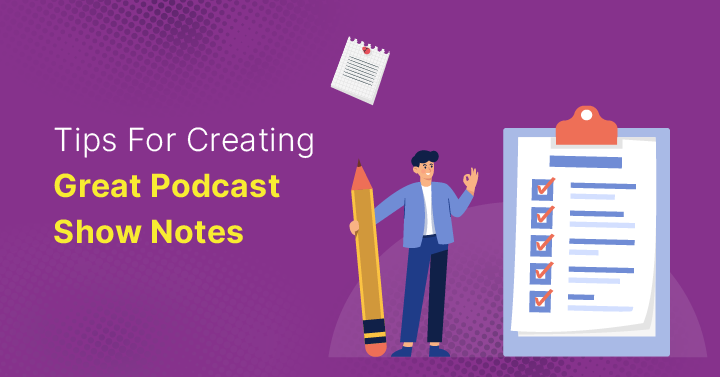
- What Are Podcast Show Notes?
- Are Podcast Show Notes Worth It?
- Tips For Creating Great Podcast Show Notes
- Keep the show notes concise
- Organize content with bullet points
- Use strong keywords and phrases for SEO
- Include transcriptions of your episodes
- Utilize images to enhance the visual appeal
- Add links to your external sources
- Include timestamps to episode summaries
- Use Call to Action to encourage listeners
- Podcast Show Notes Templates
- Examples Of Great Podcast Show Notes
- FAQs
Quite a number of podders struggle to come up with podcast show notes that can act both engaging and entertaining. These little bites of information on topics the podcast will be broaching allows listeners to cherry-pick their pod sessions to their liking. Also, with these textual accompaniments, your audience will know what to expect and might better understand everything you’re trying to convey. But, how does one write show notes that can effectively conclude all the main bits, while retaining a wow factor?
To help you along, we’ve put together this expository guide on how to write podcast show notes so that your audience want more each and every time.
1. What Are Podcast Show Notes?
First things first – what are podcast show notes and where do they go on my pod? As we’d peeked at a little earlier, these bits of writeup linked to every episode of your podcast will offer a rough insight into the main topic, multiple perspectives on the topic discusses, and house any facts shared during your session. Often, these are also linked to sites substantiating facts claimed, a transcribed copy of the discussion, even a short biography of any guest speakers – so you have an idea of their authority on the topic.
2. Are Podcast Show Notes Worth It?
2.1 Attract new listeners with SEO practice
By way of optimising these show notes for your podcast, you’ll be increasing the overall visibility and audience reach. Adding topic keywords, related search ideas, and other relevant information will help search engines to better disperse your pod episodes to the right crowd each time. You can also use this as a platform to swell up your email list – just add a quick CTA anywhere relevant and watch the leads pour in.
2.2 Helps in cross-promotion of old content
Interestingly, such summaries of your podcast conventions can be repurposed as a tool to promote your older audio content to any fresh listener groups you may have. When talking about a topic that ties in with a previous subject matter or episode that you’ve done, simply add a link to it on the relevant bit of information in your show notes. This way, your pod patrons can directly access your earlier material to have better understanding of the topic at hand.
2.3 Educates casual listeners about the show
Not only do these podcast show notes reinforce a point or perspective that you offer, they will also help your casual audience lock in all the info presented when they see it visually. You can even offer them various links, supporting documents, facts, and opinions on the matter at hand. This way, your podcast session will seem more legitimate and help you establish credibility on the topics you choose to present.
2.4 Provides a reference for future content creation
With your show notes as a pivot for future podcast episodes, the chances of you straying off your original themes and topic idea would be greatly reduced. Also, newer pods can be planned out as a mini-series spanning a few weeks, simply to address a combination of themes in a past episode.
3. Tips For Creating Great Podcast Show Notes

3.1. Keep the show notes concise
Even though you might be highly tempted to include every bit and bob you’d discovered on your research rounds, it’s best to remember that your listeners might not want to read it all. As a general rule, it’s best to keep the number of words between 100 – 200 words. Scientific research has proven that the current average Internet attention span is limited to a mere 8.25 seconds. So, anything over 200 words in your podcast show notes may be redundant.
3.2 Organize content with bullet points
Based on the analysis from one data scientist, John Schwartz, people are more inclined to look at video and image media rather than chunks of text. In some cases, people are put off from your channel or page whenever they see that they’ll need to expend effort to read your content. Considering all this, it might be the best for you and your podcast visitors to have show notes organized in bullet form.
3.3 Use strong keywords and phrases for SEO
When writing your podcast show notes, be sure to consider its role in boosting your channel’s SEO value as well. The usage of relevant, relatable, and accurate keywords that resonate with your audience will increase your chances of being found by the right crowd. Don’t be afraid to sprinkle a couple of bombastic keywords as well – these work wonders for catching reader attention – but do keep them as close to home as possible.
3.4 Include transcriptions of your episodes
To further boost SEO ranking, it’s best to have your episodes transcribed. Not only do they potentially attract the attention of those hard of hearing, any keywords, themes, and topics that are relevant to your audience will be accurately captured in your transcriptions. Simply attach these as a link below your podcast videos or audio files, or use built-in features like the podcast show notes Spotify offers.
3.5 Utilize images to enhance the visual appeal
The majority of the Internet public tends to favor images, GIFs, memes, infographs, videos, and more as opposed to long-winded text-heavy pieces. When writing your podcast show notes, be sure to use images, videos, even memes to illustrate points or highlight a fact. Rest assured that using these little media bits is much more effective, since 90% of our brains operate on visual cues.
3.6 Add links to your external sources
When making claims or revealing facts on your show notes, always make it a point to link a verifier article or site to them. These external sources lend further credibility to your research methods and compilation of information on the topic, aside from contributing a good dose of SEO juice. It’s common practice to add up to 50 links to your show notes – depending on the relevancy to the theme and talking point of your pod episode.
3.7 Include timestamps to episode summaries
Timestamps give your audience the freedom to flit back and forth between sections of your podcast, especially if they need a second listen for better understanding. In addition to that, you can use these time ticks to highlight fun, serious, funny, and memorable moments in your episodes. Having a specific link to sections will also increase the chances of your audience coming back to listen to their favorite parts of your sessions.
3.8. Use Call to Action to encourage listeners
A Call to Action, or CTA, is essentially a little nudging of your audience and leads towards the completion of your set goals for their particular target group. With podcast show notes, the most common CTAs would be affiliate and shopping links, e-book downloads, subscribe buttons, or listen snippets. Using them across the length of your show notes will increase the chance of your audience reaching the final marketing goal you have set for their demographic.
4. Podcast Show Notes Templates

4.1 Shortform Podcast Show Notes
· Episode Title – use SEO-targeted keywords that are directly relevant to your episode.
· Episode Introduction – create a keyword-rich summary of your podcast episode. Describe the gist of your session as accurately as possible without giving too much away. Use a good mix of short, mid, and long tail keywords as well as competitor, audience, and topic-tied search phrases and catchwords.
· Main Topics – introduce your topics to the audience; preferably in bullet form for easy skimming and review.
· Additional Resources – link up any authoritative resource sites, articles, or videos here. You can also drop a yoke to your guest speaker’s pages, social networking profiles, or their bio. Leave any further reading material here as well.
· CTAs – leave links leading to your podcast hosting site, email lists, newsletters, subscriptions, memberships, and monetization sites – Patreon, Tribe, and Buy Me A Coffee are excellent examples.
4.2 Longform Podcast Show Notes
· Episode Title – build a title that perfectly captures the theme and topic of your discussion and incorporate a few important keywords.
· Episode Introduction – share some insight into the discussion topics, pain points, and issues being highlighted. Again, be sure to not divulge too much here.
· Guest Bio – If you have a guest speaker, write their basic details, authority, and role, as well as their expert fields in this section.
· Key Topic 1 – Explain the major topic of your podcast with relevant timestamps and links.
· Key Topic 2 – Introduce the second theme with relevant timestamps and links.
· Key Topic 3 – further divulge the following topic with relevant timestamps and links.
· Key Topic 4 – highlight your final point with their relevant timestamps and links.
· Additional Resources – provide links to authoritative resource sites, articles, infographics and more here. Leave relevant past episodes, reading material, and speaker details here as well.
· CTAs – lead your audience to your subscription lists and monetization channels – Patreon, Tribe, and Buy Me A Coffee are some popular ones.
5. Examples Of Great Podcast Show Notes
5.1 The Tim Ferris Show
The Tim Ferris Show is centered around a variety of topics, so it makes sense for them to keep their briefs short. And while doing this, they shift the focus onto the expertise of their guest speakers, increasing the quality of the facts presented during their sessions. Aside from providing a copy of their podcast show notes directly on their streaming platform page, they have also a dedicated webpage offering these notes – cleverly linking them to all their podcast episode pages and show transcript copies across multiple platforms.
Source : The Tim Ferris Show @ Apple Podcasts
5.2 The Joe Rogan Experience
With The Joe Rogan Experience channel, you’ll note a less formal layout and language being used in the show summaries. Most of the topic points and key discussion matters are sectioned off into groups of bullet points. Interestingly, the show notes are not linked to the podcasting platform itself. Rather it’s aggregated to a dedicated page, as are the shows transcripts. This model works wonders for those looking to monetize their textual and audio content at the same time.
Source : The Joe Rogan Experience @ Spotify
6. FAQs
1. How do you add show notes to a podcast?
In most cases, your podcast hosting channels will allow for a section where you can enter both your episode description as well as your show summary. You can also choose to compile all your notes on a site devoted to it, where you would be able to link it to your lead generators and sales converters.
2. What is the difference between podcast show notes and description?
A description of your podcast captures the essence of what your podcast is about as well as a bit on what the episodes will be on. The show notes, however, are a systematic breakdown of an episode’s topics, speakers, and discussion points to give listeners a preview into what they would be getting into.
3. Where are the show notes in a podcast?
Show notes are usually posted along with the podcasts themselves. Look for a link or text section below your favorite pod channels and you should find them. For some podcasters, show notes may be found on a separate website, linked to the podcast episode.
4. Can I use a podcast show notes generator?
There is absolutely no reason not to! What an AI-powered podcast show notes generator does is that it receives your podcast file – audio or video – and is able to identify key topics and discussion points to generate an individualized summary for each of your episodes.



